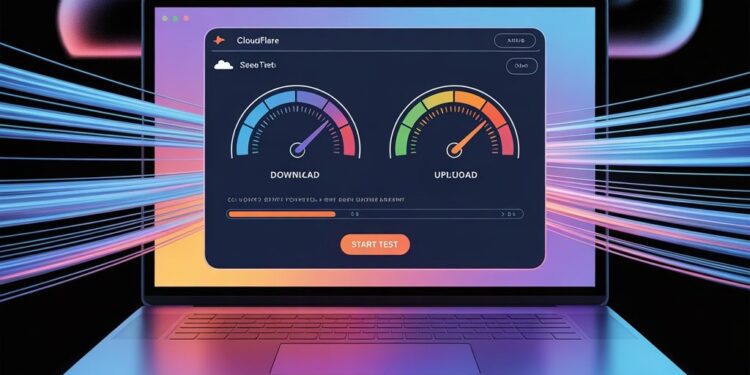Internet speed is more important than ever. Whether you’re streaming in 4K, joining video conferences, or gaming online, a fast, reliable connection can dramatically improve your digital experience. But not all speed tests are created equal. That’s where the Cloudflare speed test stands out. Known for its robust global network and emphasis on performance and privacy, Cloudflare offers a unique tool that goes beyond basic speed metrics.
In this comprehensive guide, we’ll explore everything you need to know about the Cloudflare speed test—what it is, how it works, how it compares to other speed testing tools, and how you can use it to optimize your internet performance.
What is the Cloudflare Speed Test?
The Cloudflare speed test is a web-based tool designed to measure your internet connection’s performance using Cloudflare’s extensive content delivery network (CDN). Unlike traditional speed tests that focus mainly on download and upload speeds, Cloudflare also examines latency, jitter, and packet loss—metrics that provide a deeper insight into your connection quality.
Key Metrics Measured
- Download Speed: How quickly data is received from the internet.
- Upload Speed: How fast data is sent from your device to the internet.
- Latency (Ping): The time it takes for a data packet to travel from your device to a server and back.
- Jitter: Variation in latency, which can impact real-time applications like video calls.
- Packet Loss: The percentage of data packets that fail to reach their destination.
Cloudflare collects this data from multiple servers worldwide, providing a reliable and comprehensive snapshot of your network’s capabilities.
Why Choose Cloudflare Over Other Speed Tests?
Many people are familiar with speed test tools like Ookla’s Speedtest.net or Netflix’s Fast.com. While these are useful, Cloudflare’s offering comes with a few distinct advantages:
1. Global Infrastructure
Cloudflare operates one of the largest networks in the world, with data centers in over 285 cities across 100+ countries. This ensures that test data is collected from locations that are geographically close to users, improving accuracy.
2. Advanced Metrics
Traditional tests often overlook jitter and packet loss. These metrics are critical for understanding issues with video conferencing, VoIP, or online gaming. Cloudflare brings these metrics to the forefront.
3. Privacy Focus
Cloudflare is known for its strong privacy policies. Unlike some other providers, it does not sell user data, making the Cloudflare speed test a more secure choice.
4. Open Source Transparency
The source code for Cloudflare’s speed test is publicly available on GitHub. This transparency fosters trust and allows developers to inspect or even customize the tool.
How to Use the Cloudflare Speed Test
Using the Cloudflare speed test is straightforward:
- Navigate to https://speed.cloudflare.com.
- Wait a few seconds for the test to begin automatically.
- Review the results, which are displayed in a clean, user-friendly interface.
Pro Tips for Accurate Testing
- Use a Wired Connection: For the most accurate results, use an Ethernet cable instead of Wi-Fi.
- Close Background Apps: Ensure no other applications are consuming bandwidth.
- Test Multiple Times: Run the test at different times of day to get a comprehensive view.
- Reboot Your Router: Periodically restarting your modem/router can help clear up network congestion.
Understanding Your Results
Download and Upload Speeds
These are typically expressed in Mbps (megabits per second). Higher numbers generally mean faster internet. For streaming and general browsing, 25 Mbps download is usually sufficient. Upload speeds are crucial for video calls and cloud backups.
Latency
Expressed in milliseconds (ms), lower latency is better. Anything under 30ms is ideal for most online activities. Higher latency can cause lag in online games and buffering in live streams.
Jitter
This measures the consistency of your internet connection. Low jitter ensures stable communication. High jitter causes disruptions in video/audio.
Packet Loss
Zero packet loss is the goal. If you see consistent packet loss, it may indicate issues with your ISP, your router, or network interference.
How to Improve Poor Speed Test Results
If the results from your Cloudflare speed test are below expectations, there are several steps you can take:
Optimize Your Hardware
- Upgrade Equipment: Older routers and modems can become bottlenecks.
- Use Mesh Wi-Fi: This ensures coverage throughout your home, especially in larger or multi-story buildings.
Improve Network Configuration
- DNS Optimization: Switching to Cloudflare’s 1.1.1.1 DNS can decrease lookup times.
- QoS Settings: Enable Quality of Service in your router to prioritize bandwidth for essential apps.
Eliminate Interference
- Reduce Device Load: Limit the number of devices using the network during testing.
- Avoid Signal Blockers: Physical barriers like walls and electronic interference can impact Wi-Fi performance.
Work with Your ISP
- Verify Your Plan: Make sure you’re getting the speed you’re paying for.
- Request a Technician Visit: Sometimes internal wiring or equipment needs professional adjustment.
Cloudflare Speed Test vs. Competitors
Feature |
Cloudflare Speed Test |
Speedtest.net |
Fast.com |
|---|---|---|---|
Latency & Jitter |
Yes |
Latency only |
No |
Packet Loss |
Yes |
No |
No |
Open Source |
Yes |
No |
No |
Server Location Transparency |
Yes |
No |
Limited |
Privacy Focus |
Strong |
Moderate |
Moderate |
Metrics Depth |
Comprehensive |
Basic |
Basic |
Summary
While all these tools are useful, the Cloudflare speed test excels in delivering detailed, transparent, and privacy-respecting results.
Practical Applications of the Cloudflare Speed Test
Home Network Troubleshooting
Families with multiple users streaming, gaming, or working remotely need consistent bandwidth. Regularly running the Cloudflare speed test can help pinpoint when and why slowdowns occur.
Business Internet Monitoring
Businesses can benefit from continuous monitoring using the Cloudflare test, especially those with remote employees or VoIP systems.
Development and Testing
Developers can use Cloudflare’s GitHub-hosted tool to create custom speed tests or integrate with internal systems.
FAQs
Is the Cloudflare speed test free?
Yes, it is entirely free to use and does not require any sign-up or software installation.
How accurate is the Cloudflare speed test?
Thanks to Cloudflare’s global network and transparent testing methodology, it is among the most reliable tools for network diagnostics.
Can I run the test on mobile?
Absolutely. The site is fully responsive and optimized for mobile browsers.
Does the test affect my data usage?
Yes. Like any speed test, it transfers data to measure performance. Keep this in mind if you’re on a limited data plan.
Can I see historical results?
Currently, the web interface does not save results, but you can screenshot or record them manually. Developers can use the source code to build custom loggers.
Is Cloudflare’s speed test better for gaming?
Yes. Because it measures jitter and packet loss, it provides more relevant data for online gaming performance than basic tests.
Conclusion
The Cloudflare speed test is more than just another internet performance tool. It provides a rich set of metrics including latency, jitter, and packet loss—making it ideal for users who want a deeper understanding of their internet quality. Its user privacy policies, transparency through open-source code, and global infrastructure add layers of trust and accuracy unmatched by other platforms.
Whether you’re trying to optimize your home Wi-Fi for streaming, manage enterprise network performance, or simply troubleshoot slow internet, the Cloudflare speed test equips you with the right data to make informed decisions.
Use this powerful tool regularly and apply the insights gained to enhance your network experience. With better understanding comes better performance—and fewer interruptions in your digital life.
For consistent, transparent, and detailed insights, the Cloudflare speed test is an essential tool in your internet toolkit.









